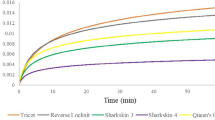Abstract
Modeling of soft finger contact mechanics is a prerequisite for gripper design. Realism of soft finger deformations depends extremely on the selection of appropriate hyper-elastic material model for soft materials. The essential criterion for a good mathematical model for hyper elasticity is its ability to match the measured strain energy curves under different deformations over a large range. Selecting an appropriate material law for a given material combination is one of the most difficult tasks in soft finger contact modeling. The present study is devoted for comparing seven popular hyper-elastic non-linear material models (Mooney–Rivlin, Ogden, Yeoh, Neo-Hookean, Gent, Polynomial and Aruda–Boyce model) and selection of the most appropriate model based on experimental data for modeling of soft contact problems. Present results clearly reveal that Ogden and Neo-Hookean model are more suitable for these problems and in line with the experimental results. Finite element technique is employed for critical comparison of various hyper-elastic material models.



Similar content being viewed by others
Abbreviations
- a :
-
Contact radius
- c:
-
Proportionality constant
- ϒ:
-
Constant that varies from 0 to 1/3
- W :
-
Strain energy function
- I 1, I 2, I 3 :
-
Strain invariant
- \( \lambda_{1} \lambda_{2} \lambda_{3} \) :
-
Principal stretch ratios
- C :
-
Material constant
- μ:
-
Initial shear modulus of the material
- d :
-
Incompressibility parameter
References
ANSYS 11.0 Documentation, ANSYS Inc. (2008)
Boyce, M.C., Arruda, E.M.: Constitutive models for rubber: a review. Rubber Chem. Technol. 73, 504–523 (2000)
Cutkosky, M.R., Jordain, J.M., Wright, P.K.: Skin materials for robotic fingers. In: Proceedings of the 1987 IEEE International Conference on Robotics and Automation, pp. 1649–1654, Los Alamitos (1987)
Gent, A.N.: A new constitutive relation for rubber. Rubber Chem. Technol. 69, 59–61 (1996)
Han, H.-Y., Shimada, A., Kawamura, S.: Analysis of friction on human fingers and design of artificial fingers. In: Proceedings of the 1987 IEEE International Conference on Robotics and Automation, pp. 3061–3066. Washington (1996)
Hertz, H.: On the contact of rigid elastic solids and on hardness. In: Assorted Papers, MacMillan, New York (1882)
Kinoshita, H., Backstrom, L., Flanagan, J.R., Johansson, R.: Tangential torque effects on the control of grip forces when holding objects with precision grip. J. Neurophys. 78(3), 1619–1630 (1997)
Mooney, M.: A theory of large elastic deformation. J. Appl. Phys. 11, 582–592 (1949)
Natarajan, E., Marappan, R.: Analysis on the fundamental deformation effect of a robot soft finger and its contact width during power grasping. Int. J. Adv. Manuf. Technol. 52, 797–804 (2011)
Ogden, R.W.: Recent advances in the phenomenological theory of rubber elasticity. Rubber Chem. Technol. 59, 361–383 (1986)
Ogden, R.W.: Non-linear elastic deformations. Ellis Horwood, Chichester (1984)
Renaud, C., Cros, J.-M., Feng, Z.-Q., Yang, B.: The Yeoh model applied to the modeling of large deformation contact/impact problems. Int. J. Impact Eng. 36(2009), 659–666 (2009)
Schallamach, A.: The load dependence of rubber friction. Proc. Phys. Soc. 65(9), 657–661 (1969)
Seifert, S., Kuster, S., Dillmann, R.: Comparison of Yeoh, Mooney–Rivlin and St-Venant–Kirchhoff materials for passive modeling of skeletal muscles Surgetica, Chambery (2005)
Tatara, Y.: Extensive theory of force-approach relations of elastic spheres in compression and in impact. J. Eng. Mater. Technol. ASME 111, 163–168 (1989)
Tatara, Y.: On compression of rubber elastic sphere over a large range of displacements. Part 1: theoretical study. J. Eng. Mater. Technol. ASME 113, 285–291 (1991)
Tatara, Y., Shima, S., Lucero, J.C.: On compression of rubber elastic sphere over a large range of displacements. Part 2: comparison of theory and experiment. ASME J.Eng. Materials Tech 113, 292–295 (1991)
Xydas, N., Kao, I.: Modeling of contact mechanics and friction limit surface for soft fingers with experimental results. Int. J. Robot. Res. 18(9), 941–950 (1999)
Xydas, N., Bhagavat, M., Kao, I.: Study of soft finger contact mechanics using finite elements analysis and experiments. In: Proceedingsof the 2000 IEEE International Conference on Robotics and Automation, pp. 2179–2184, San Francisco (2000)
Yeoh, O.H.: Some forms of the strain energy function for rubber. Rubber Chem. Technol. 66, 745–771 (1993)
Author information
Authors and Affiliations
Corresponding author
Rights and permissions
About this article
Cite this article
Venkatesh Raja, K., Malayalamurthi, R. Assessment on assorted hyper-elastic material models applied for large deformation soft finger contact problems. Int J Mech Mater Des 7, 299–305 (2011). https://doi.org/10.1007/s10999-011-9167-1
Received:
Accepted:
Published:
Issue Date:
DOI: https://doi.org/10.1007/s10999-011-9167-1




